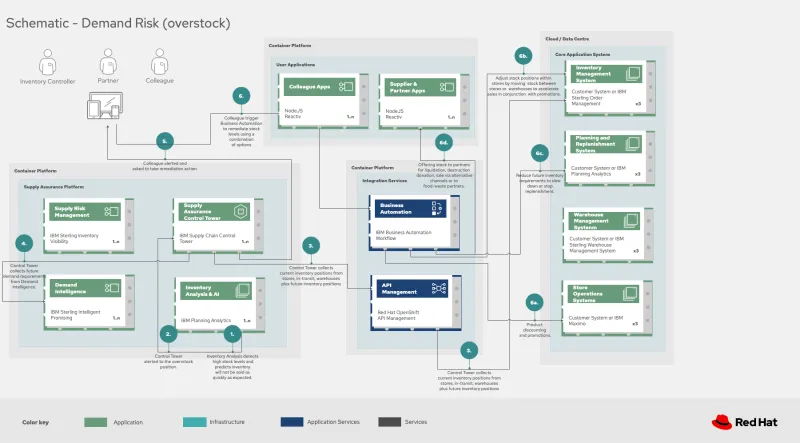A fundamental goal for supply chains of physical goods is matching up available inventory with demand.
You can have too little of something (understock). During the pandemic, everyone became familiar with this scenario, whether it involved waiting months for a new car or scrounging all the local markets for toilet paper. These examples illustrate two of the ways in which businesses can fail to align with customer demand. In the case of automobiles, shortages in key components like microprocessors constrained what manufacturers could build. In the case of toilet paper, because people weren't in offices (and were maybe hoarding a bit) caused a spike in consumer demand.
But overstock is bad, too. Products or components sitting on a shelf or in a warehouse represent capital that’s sitting idle and some products can spoil if they sit for too long. This problem is most obvious in the case of food and other perishables, but it’s not limited to literal spoilage. Clothes can become last year’s style. The 2023 electronics gadget isn’t going to be worth as much once new models are announced at the Consumer Electronics Show the next year.
Business problem
Clearly, inventory optimization is a critical element of any organization's fulfillment process. It represents a balancing act between two key aspects of that process.
The first aspect is demand. The business needs to understand their current demand for products, goods and services—as well as forecasting their future demand.
The second aspect is inventory. The business needs to have a clear understanding of all the inventory held within their fulfillment system. An inventory management system provides oversight of current inventory and inventory changes due to purchases.
Inventory optimization is about making sure the current and future demand is accurately balanced against current and future inventory. Getting the balance right leads to a successful and profitable business. Getting the balance wrong leads to failure and, in the worst case, eventual collapse of the business.
Challenges include carefully managing inventory control, especially of high value and perishable items. Retail businesses with many locations also require managing inventory and the shipment of inventory at the store level. Forecasting, especially in light of events that cause unpredictable demand changes, is another challenge, as is efficiently handling overstocking and understocking when they inevitably happen in spite of your best efforts.
Meeting these challenges brings big benefits though. Faster inventory turnover leads to higher profits. Being able to meet customer demand improves the customer experience, which can lead to more sales and profits over time.
Let’s consider a solution that helps match up inventory with demand to handle understock and overstock events. The following summarizes a published Portfolio Architecture that diagrams and explains the solution in more detail.
Solution overview
The solution uses the following technologies, which can be grouped into three main categories as shown in the diagram:
- Core application systems. These are often customer-provided technologies, such as order management and facilities management. These systems can include standalone applications, on-premises and cloud services, and databases.
- Foundational infrastructure. The Red Hat/IBM solution is built on Red Hat OpenShift with data routed through API management and events routed through business automation tools such as Business Automation Workflow.
- Inventory Optimization platform. This consists of a Supply Assurance Control Panel, Fulfillment Optimization, and Inventory Analysis and AI.

Understock and overstock workflows
The charts in this section demonstrate the interaction of customer systems with supply chain optimization platform systems in the context of a retail scenario with branch stores.

Understock workflow summary
When the Inventory Analysis block detects low stock levels and predicts inventory will become unavailable sooner than originally expected, it alerts the Inventory Control Tower to the understock position. The Inventory Control Tower then collects current inventory positions from stores, in-transit and warehouses plus future incoming inventory.
Inventory Control Tower also collects future demand requirements from Demand Intelligence. The “Colleague” (humans in the loop) is alerted and asked to take remediation action.
The Colleague now triggers Business Automation to remediate stock levels using a combination of options, including: ordering more stock, adjusting stock positions within the existing Supply Chain, managing inventory held at existing stores/warehouses and moving existing inventory as appropriate.

Overstock workflow summary
The initial overstock workflow is similar except, in this case, the Inventory Analysis detects high stock levels and predicts inventory will not be sold as quickly as expected and alerts the Inventory Control Tower of this fact. It then collects current and future inventory positions and alerts Colleague to take action.These actions can include moving inventory around, perhaps in conjunction with promotions and discounts.
Summary
Inventory optimization is making sure that current and future demand is accurately balanced against current and future inventory. Getting the balance right leads to a successful and profitable retail business. Getting the balance wrong leads to unhappy customers, reduced profitability and potential waste.
At a high level, there are several main steps your organization can take to drive innovation and modernize your supply chain relating to categories such as automation, modernization and sustainability. For specific steps on this approach, see The Action Guide details in Own your transformation survey of 1500 CSCOs across 24 industries.
If you are interested in more solutions built with these and other products in Red Hat's portfolio visit the Portfolio Architecture website and the Demand Risk Portfolio Architecture, in particular.
Supply Chain blog series
This blog is part of a Supply Chain blog series:
- Supply chain optimization imperative - Read the blog
- Supply chain optimization - See the blog and associated Portfolio Architecture
- Demand risk – this blog and associated Portfolio Architecture
- Loss and waste management (coming soon)
- Product timeliness (coming soon)
- Perfect order (coming soon)
- Intelligent order (coming soon)
- Sustainable supply (coming soon)
References
- McKinsey: How COVID-19 is reshaping supply chains
- Harvard Business Review: Three steps to prepare your supply chain for the next crisis
- Gartner: What is a Supply Chain Control Tower and what's needed to deploy one
- Gartner: Fulfillment Forecasting: The Key to Optimizing Retail Inventory Positioning
- Gartner: Supply Chain Risk Management (SCRM): What & Why Is It Important
- IBM Institute for Business Value: Own your transformation
- IBM Institute for Business Value: Balancing sustainability and profitability
- What is sustainability in business?
執筆者紹介
Bruce joined IBM as a Solutions Architect focusing on distribution and communication sectors in the industry market in 2021 in Client Engineering. Bruce has been a solutions architect since 2001. He led the initial cloud migrations to Microsoft Azure, managed research compute resources at Microsoft Research and built out Kubernetes implementations.
As a Chief Architect for Retail in the UK, Boyle engages in strategic dialog with IT decision makers and influencers across the ecosystem of Red Hat customers and partners. Boyle collaborates with architects and technologists across the globe to unlock the potential of open source solutions.
類似検索
New efficiency upgrades in Red Hat Advanced Cluster Management for Kubernetes 2.15
Revolutionizing learning: How Ford's Kubernetes community sparks technological innovation
Technically Speaking | Build a production-ready AI toolbox
AI Is Changing The Threat Landscape | Compiler
チャンネル別に見る
自動化
テクノロジー、チームおよび環境に関する IT 自動化の最新情報
AI (人工知能)
お客様が AI ワークロードをどこでも自由に実行することを可能にするプラットフォームについてのアップデート
オープン・ハイブリッドクラウド
ハイブリッドクラウドで柔軟に未来を築く方法をご確認ください。
セキュリティ
環境やテクノロジー全体に及ぶリスクを軽減する方法に関する最新情報
エッジコンピューティング
エッジでの運用を単純化するプラットフォームのアップデート
インフラストラクチャ
世界有数のエンタープライズ向け Linux プラットフォームの最新情報
アプリケーション
アプリケーションの最も困難な課題に対する Red Hat ソリューションの詳細
仮想化
オンプレミスまたは複数クラウドでのワークロードに対応するエンタープライズ仮想化の将来についてご覧ください

